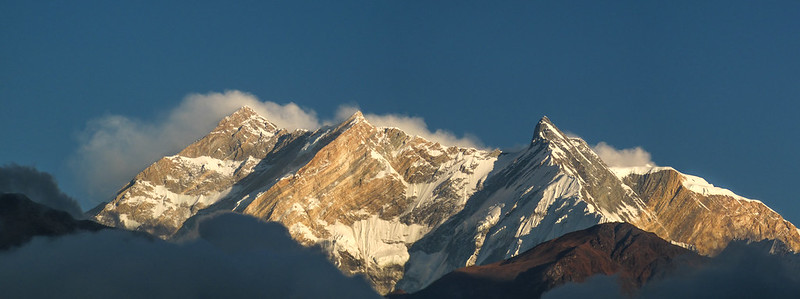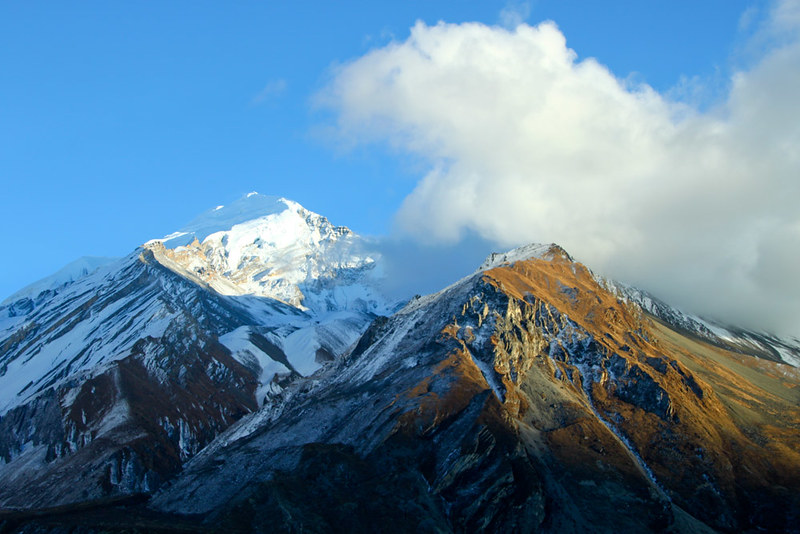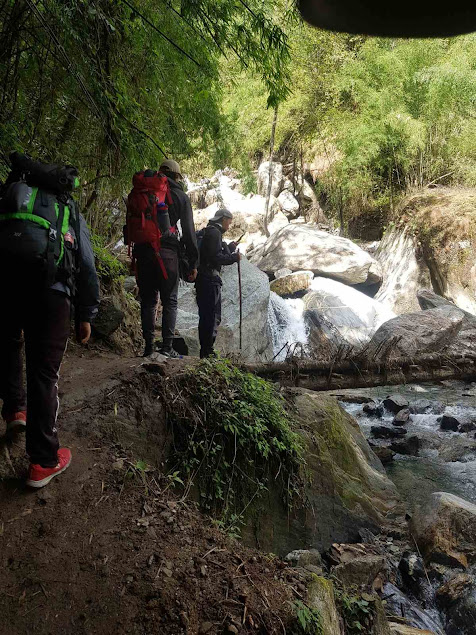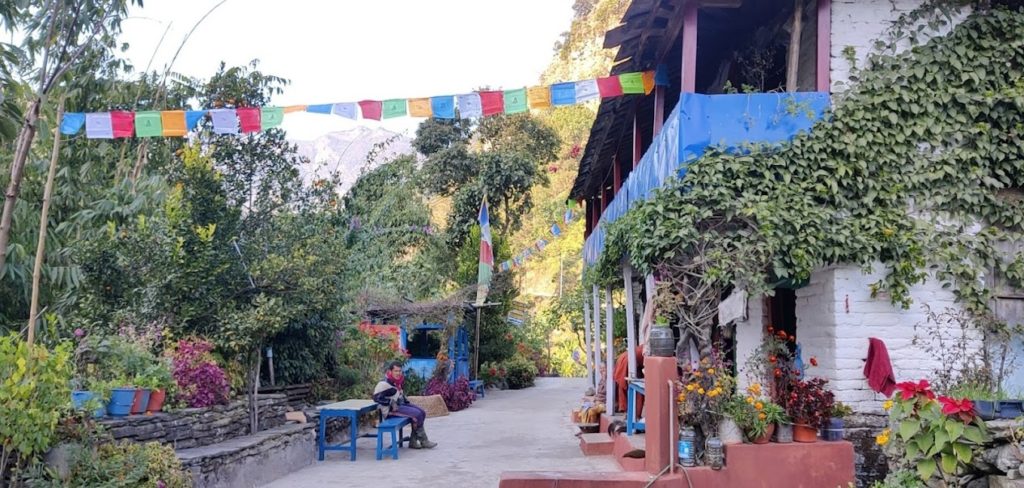The Annapurna Circuit Trek is one of the most well-known treks in the Himalayas. Most fit hill walkers can complete this excursion, which involves a crossing of the Thorong La (pass) at 5416 meters.
Annapurna Circuit Trek is social and enjoyable, not too strenuous, and nights are spent in luxurious lodges with fresh and high-quality meals. It’s a round journey that takes you up one valley, over the Thorang La high pass (5412m), and down another valley. The western portion of the route is now accessible to cars, which means that owing to traffic and dust, this section is best traveled by vehicle; nevertheless, this only gives the feet daybreak, and the remainder of the walk is breathtaking.

Annapurna Circuit Trek does not need you to be an expert trekker, but in the end, you will be mountain-fit, tanned, and full of optimism! In the busy season, it’s safe to say that this is a popular journey, and you’ll come across people from all over the world on the path. It’s difficult at times, but the route provides for great acclimatization before climbing the pass, and you’ll be in the safe and capable hands of our guide team.
Highlights of The Annapurna Circuit Trek
- Cross the Thorung La Pass on the Annapurna Circuit to reach a height of 5416 meters and ascend to the clouds. This is a tremendous achievement in terms of putting your intellect and body to the test.
- Discover a new side of the Himalayas by walking through terraced rice fields, oak and rhododendron forests, and other natural wonders in the Annapurna area during the Annapurna Circuit Trek.
- While staying in teahouses in tiny towns along the way, learn about life in Nepalese mountain settlements, meet locals, and meet other trekkers.
- Thorang La Pass, Marshyangdi, and Gandaki River Valley will connect you to two spectacular river valleys on your Annapurna Circuit Trek. It provides one of the most delightful excursions thanks to its distinctive land structure and beautiful natural surroundings.
- The climb to the foothills of Machhapuchre Mountain (6993m), Annapurna’s neighboring mountain, is also one of the expedition’s highlights. The major draw is the peak’s unusual form, which resembles the tail of a fish, thus the name “Machhepuchre.”
- Muktinath Temple is one of the Annapurna Circuit Trek’s most prominent cultural and religious landmarks. After going via Thorang La Pass, hikers arrive at this location.
- Jomsom, nestled on the banks of the raging Kali Gandaki River with its magnificent scenery and friendly locals, is one of the most famous places for trekkers to spend a night along the Annapurna Circuit Trek.
- Marpha Village is one of the greatest places to visit on the Annapurna Circuit Trek if you want to learn about local culture and meet local people. It is also known as “Nepal’s Apple Capital,” since it is the country’s major apple grower and, with its beautiful surroundings, a good site for trekkers to spend the night.
Best Time for Annapurna Circuit Trek
Autumn in the Himalayas occurs in September, October, and November, with October being the ideal month for the Annapurna Circuit Trek. The rainfall has brought with it cleaner air and dust-free paths. This is peak hiking season, so expect tea houses to be crowded, particularly in Manang.
The Annapurna Circuit Trek may be done in the winter, with November and December providing a pleasant break from the summer hordes. Be ready for frigid days and even colder nights, as well as the chance of snow delays or diversions.
The Thorong La crossing is difficult in January because of heavy snowfall, and many trekkers will find the path closed.
Warmer, longer days abound in February, March, and early April, providing a delightful alternative to the popular autumn trekking season, which is awash in pink rhododendrons in full bloom during Annapurna Circuit Trek.
May is warm, especially at lower elevations, but it also brings the threat of pre-monsoon rain. As a result, you’ll need to be well-equipped with rain gear.
The monsoon season begins in June, July, and August, with severe rains threatening to flood rivers in the circuit’s lower parts and cause landslides on the circuit’s fragile slopes.
While it may not rain every day and the landscape becomes lush and green, views of the Himalayas will be largely covered by clouds. Overall, try to avoid it if at all possible.

Annapurna Circuit Trek Difficulty
Nepal is recognized as a mountainous nation, and thousands of tourists go to the country each year to see the beautiful scenery and mountains. The majority of tourists are trekkers who want to immerse themselves in the alpine culture. Also, journey into the foothills of the Alps and through rural hilly terrain.
Annapurna Circuit Trek and Annapurna Base Camp Trek are two of the most popular trekking routes, vying with the ever-popular Everest Base Camp Trek. The Annapurna Circuit Trek is located in the Annapurna area, which is home to Mount Annapurna (8091m), the world’s tenth-highest mountain. The Annapurna Circuit is a journey that circuits the Annapurna Range.
Annapurna Circuit Trek takes you through a diverse scenery that includes everything from rural communities and rice fields to subtropical woods, hills, waterfalls, and massive mountains. Greenwoods with rich flora and fauna, towns with terraced farms, and beautiful rivers and lakes are only a few of the attractions.
The breathtaking views of Himalayan peaks like Mount Annapurna I and II, Dhaulagiri, Nilgiri, Manaslu, Machhapuchchhre, and many others entice you to go on this journey. Several factors influence whether a journey is easy or tough. We’ve listed a few things that will make your hiking journey more enjoyable.
The Annapurna Region is well-known and valued not just for its breathtaking beauty, but also for its ease of access. The Annapurna Circuit Trip is a somewhat difficult and long trek in the region. As a result, a rookie trekker may find it more difficult to finish the route without prior training and planning.
For every trekker, the Annapurna Circuit Trek is one of the most exhilarating and adventurous treks available. Thorong La Pass, at 5,500 meters above sea level, is the highest point on the hiking route and one of the trek’s highlights.
Fitness Level for Annapurna Circuit Trek
Doing the Annapurna Circuit Trek for around seventeen days straight is exhausting, and being fit is certainly advantageous, but keep in mind that you will be exercising every day during the trek and will end up being fantastically mountain fit, and there will be rest on day 13 when we drive out of altitude along the western road. So, prepare ahead of time by walking a lot with a daysack, but don’t overdo it. Although it is not a marathon, there are several hills to climb and descend!

Working on your thigh muscles, calf muscles, and shoulders for carrying the bag (it’s just about 5kg, but it seems like 10 while you’re going uphill in the sun) is recommended for the high pass. The days aren’t too long, the path is good, and the porters are helpful, but you’ll get a lot more out of this Annapurna Circuit Trek if you’ve worked on your fitness before the trek. the Annapurna Circuit Trek will be ideal for anyone looking to drop a little weight. Return to the gym-toned, healthy, detoxed, and a few pounds lighter!
Altitude Sickness during the Annapurna Circuit Trek
When trekking in the Himalayas, the most important considerations are appropriate acclimatization and staying hydrated. The altitude as a primary worry may pose trouble as you go higher.
The oxygen level and air pressure decrease as you go above sea level. As a result, your body must learn to adapt. As a result, acclimatization at various resting sites should not be overlooked.
Early signs of altitude sickness should be observed, and any symptoms should be addressed as soon as possible. To avoid future issues, you must instantly drop to a lower height. Nausea, diarrhea, headaches, lack of appetite, exhaustion, and sleeplessness are all frequent symptoms of altitude sickness.
Thorang La Pass, at 5,500 meters above sea level, is one of the most popular and demanding locations on this Annapurna Circuit trek route.
Keep yourself hydrated and acclimate adequately to avoid altitude sickness. Taking alcoholic drinks is prohibited at high altitudes.
If the circumstance necessitates it, anti-altitude sickness medicine might be administered. To rule out possible risks, it is essential to check your doctor before taking any medication.
Food and Accommodation during the Annapurna Circuit Trek
The lodges are managed by local families and provide excellent lodging in Annapurna Circuit Trek. Each lodge includes a central public space with a huge stove that offers warmth and ambiance. The bedrooms are usually unheated and include two beds, mattresses, pillows, and a blanket. You’ll need a sleeping bag (3 seasons is usually plenty), as well as a pillowcase.

The lodges typically feature gas-powered showers and primarily employ sit-down flush toilets (some lodges do also have squat toilets). The lodges’ food is of excellent quality, a blend of traditional Nepalese and Western dishes.
Burgers and fries, as well as Dal Bhat with rice, are popular meals. In the lodges and stores, you’ll find everything from fresh croissants to beer, and stir-fries to deep-fried Mars bars. A pricing guide for Nepal may be found here. There are also several businesses providing a variety of beverages and snacks, as well as candies and chocolate during the Annapurna Circuit Trek. You may also purchase any equipment you may have forgotten on the path or in Kathmandu.
Annapurna Circuit Trek Recommended Itinerary
Day 1: Arrival in Kathmandu (1,300 m)
On the first day of our trip, we send our organization frontmen to pick you up at Tribhuwan International Airport. You will be heartily welcomed and shifted towards a tourist standard hotel by our private vehicle. We also plan on meeting at our office for a discussion regarding our trek.
Day 2: Sightseeing and preparation
Kathmandu Valley is considered as ultimate spot to see major cultural and historical sites. On the second day after finishing our morning breakfast, we move on to sightseeing some historical places that are listed as UNESCO World Heritage Sites. Therefore exploring these locations, we returned to finalize our trekking equipment, which is required during our upcoming trek, and this night we spent at the same hotel in Kathmandu.
Day 3: Kathmandu to Besisahar (760 m)
Early morning of the third day, you will be shifted towards the bus station by our private vehicle to catch a tourist standard bus to Besisahar. After some moments, our journey starts by heading toward the west of the valley to Dumre by catching Prithvi Highway. Therefore changing the direction towards the north from Dhumre, we reach Besisahar along our accommodation and dinner will be arranged at a lodge there.
Day 4: Besisahar to Bahundanda (1,398 m)
Today, the first official trek day for Annapurna Circuit Trek starts towards the north from Besisahar by following a dusty path along passing sub-tropical forest and terraced rice fields with marvelous views of high waterfalls and snow-capped mountains including Mt Manaslu and many more others till we step Nagdi (small town). After there, moving forward the cross-suspension bridge over the Nagdi River takes to Bahundanda. Tonight’s accommodation and dinner will be arranged at the lodge in Bahundanda.
Day 5: Bahundanda to Chamje (1,410 m)
On the fifth day after a sweet breakfast, we steeply drop down to view the glorious waterfall at Syange, and from that point, the trail develops comparatively tougher than earlier. Therefore, we cross a suspension bridge over the Marsyangdi River and head towards Jagat by following the trail side by the river and vertically ascending finally taking to Chamje. This night will be spent at a lodge in Chamje.
Day 6: Chamje to Bagarchhap (2,080 m)
Today, we enter Manang district by leaving Lamjung district behind. Early morning developed trek, drops down to cross the bridge over Marsyangdi River after crossing the bridge, we follow the bank of Marsyangdi River and climb up to Tal Phedi which is an opening village of Manang District. Catching our trail, we move forward by passing Tibetan settlements and apple orchards to reach Bagarchhap for a stay overnight.
Day 7: Bagarchhap to Chame (2,720 m)
On day seven, our trail ascends to Danaque, and following a higher route from there, we pass numerous settlements with a dramatic view of high mountains including Mt. Annapurna and Mt. Manaslu to reach Tyana. After that, crossing the pine forest following the rough trail with lots of up and down, and crossing the river several times takes to Chame. Accommodation and dinner will be managed at a lodge in Chame for this night.
Day 8: Chame to Pisang (3,060 m)
Today leaving Chame, we develop our walk forward through the steep trail that takes us into the dense Oak and Maple forest. Therefore crossing two long bridges, we move forward till the trail bends to join the trail that takes us to Pisang. Finally, after steeping lower Pisang, we ascend upward to the village of Upper Pisang for a stay overnight.
Day 9: Pisang to Manang (3,440 m)
Leaving Pisang behind, we move forward towards a drier segment of the Manang district. After covering some distance, two routes are offered to step Mungi for you. If you wish to trek through the easy route then we follow the southern route (via Hongde) otherwise we trek through the northern one which is a bit harder and longer route (via Ghyaru) and finally after steeping Mungi, we cross Bryanga en route to reaching Manang for staying overnight.
Day 10: Acclimatization day
To this day, we have already steeped above the height of 3,400 m from sea level so focusing upon acclimatization, we don’t develop our trek forward but we stay active and plan to hang out on different options like exploring settlements, inspecting ancient monasteries, or ascending to Changer viewpoint to enjoy views of magnificent mountains. This night will also be spent at the same lodge in Manang.
Day 11: Manang to Ladar (4,230 m)
After a full day of acclimatization in Manang, we start a steep climb through alpine and juniper forests leaving Marsyangdi River and crossing numerous pleasing settlements with the giant view of high mountains including Annapurna and Tilicho peaks takes to Yak Kharka. Continuing our walk forward enjoying yaks and horses grazing throughout meadows, take to Ladar to stay in the lodge there.
Day 12: Ladar to Thorong La Phedi (5,416 m)
Triggering Ladar, we move forward catching an easy trail that drops down to the river to cross a wooden bridge. Therefore climbing up to the tea house by crossing the river, makes your trial more challenging than earlier and takes you to Thorong la Phedi through the cliff. After facing that challenging walk and steeping day aimed destination, accommodation, and dinner will be arranged at a lodge in Thorong la Phedi.
Day 13: Throng la Phedi to Muktinath (3,710 m)
From Throng la Phedi, we start our walk early morning towards the highest elevation of the entire Annapurna circuit (top of Throng la Pass – 5,416 m) to avoid day wind. We reach the top before the day wind starts and after enjoying a view of the stunning Annapurna circuit and Dhaulagiri with numerous other magnificent peaks being decorated by morning sun rays, we descend downhill to Muktinath to spend the night.
Day 14: Muktinath to Marpha (3,500 m)
Today, our morning-developed trail drops down towards Kali Gandaki Valley following its bank to reach Jomsom. From there, continuing the walk forward passing through apple orchards and numerous settlements takes to Marpha (the apple capital of the nation). We utilize the remaining hours by exploring the nearby apple brandy factory and this night will be spent at a lodge in Marpha.
Day 15: Marpha to Ghasa (2,010 m)
After attending morning breakfast at Marpha, following our rough and dusty trail bypassing the valley along the Kali Gandaki River with a magnificent view of towering mountains including Annapurna. Dhaulagiri, Nilgiri, and many more others take to Ghasa. Accommodation and dinner will be arranged at the lodge in Ghasa.
Day 16: Ghasa to Tatopani (1,190 m)
Quitting the village of Ghasa behind, the trail drops down and makes us cross the suspension bridge. The continuing trail leads towards the biggest waterfall along takes us to the deepest George of the world before reaching Tatopani. Finally, after stepping there, we relax our tired muscles by enjoying a dip in a natural hot stream and the night will be spent at a lodge in Tatopani.
Day 17: Tatopani to Ghorepani (3,194 m)
Early morning, we develop our trek forward to cross a long walk from Tatopani. Moving forward crossing the bridge over Kali Gandaki River takes to the junction point of two trails Beni and Ghorepani. We move forward by following the upper trail to Ghorepani, steeping upward through difficult stone steps and crossing pleasing forests with the wonderful view of towering mountains along encountering numerous settlements till Ghorepani. The night will be spent at a lodge in Ghorepani.
Day 18: Ghorepani to Poon Hill and Pokhara
Today is the last day to walk, In the early morning we hike up to Poon Hill aiming to reach on vantage point before sunrise. The view of morning sunrays striking high towering snowcapped mountains is stunning. After enjoying and capturing some moments throughout, we return and hike until we step Nayapul and leave Nayapul, we catch a bus towards Pokhara and join a tourist standard hotel there to spend overnight.
Day 19: Pokhara to Kathmandu
After having an early morning breakfast, we leave Pokhara and move ahead to catch a tourist standard bus towards Kathmandu. Finally, after reaching Kathmandu, our private vehicle will pick you up and transfer you to a fine tourist standard hotel. We host for welcome dinner in the famous local restaurant, where you can enjoy Nepalese ethnic dance and music with delicious Nepali food items.
Day 20: Departure day
On the final day of our Annapurna Circuit Trek, you can go out to buy some gifts for your loved one by managing time before your flight. Our private vehicle provides drop-off service for you towards the airport focusing on your flight time, for your final departure, and our representative wishes for your safe journey and successful forward steps ahead in the upcoming days.
Permits for Annapurna Circuit Trek
- For foreigners, the ACAP permit charge is 3,000 NPR (about USD 30).
- For SAARC nationals, the ACAP entrance permit charge is 200 NPR.
- Permit for TIMS: 1,000 NPR (about USD 10)